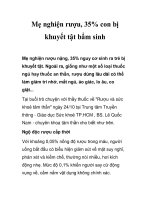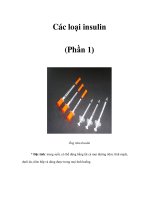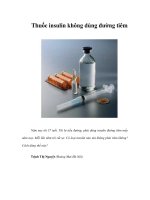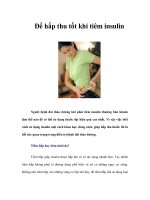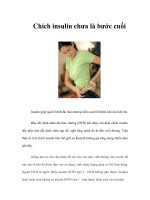35 PEDs insulin
Bạn đang xem bản rút gọn của tài liệu. Xem và tải ngay bản đầy đủ của tài liệu tại đây (750.98 KB, 16 trang )
UNIVERSITY
PEDs
Insulin Deployment
Lesson Overview
AAS/GH/Insulin Synergy
Insulin and Hypertrophy
Endogenous verse Exogenous Insulin
Why use exogenous insulin?
When to implement exogenous insulin?
Long Acting Basal Insulin Protocol
Fast Acting Meal-time Insulin Protocol
Should you cycle insulin?
Precautions with insulin therapy?
AAS + GH+ Insulin Synergy
AAS effects:
Testosterone alone increase GH/IGF-1 expression, while non/low aromatizing androgens causing
much less of an impact. (nandrolone/trenbolone)
AI and SERM usage attenuate the effects of testosterone on GH/IGF-1, AI is less impactful on GH
hepatic action than a SERM.
Increased GH receptor expression in skeletal muscle
Increased local IGF-1 mRNA expression in skeletal muscle
Nearly 95% of all circulating IGF-1 exists in a bound state (most bound to IGFBP-3, 6 other isoforms).
Binding proteins increase bioavailability, extend serum life. Can inhibit or enhance IGF action. AAS
Decreased IGFBP-4 in local muscle, increase IGFBP-3 systemically.
GH effects:
GH and AAS enhance collagen synthesis
GH stimulated JAK/STAT5 pathway direct relationship with local IGF-1, this pathway is also
downstream target for androgen receptor gene expression. So, GH increase AR expression (GH
makes your current AAS more effective).
Insulin effects:
Insulin has a permissive effect to optimize nutrient update and AAS GH/IGF-1 Synergies
Insulin increases GHR, reverses IGF-1 desensitization, stimulates GH to IGF-1 expression.
There is also a desensitized refractory period within the JAK/STAT5 for ~5hours post GH
administration where further administration does not cause same IGF-1 Response (Frost)
Insulin can sensitize the JAK/STAT5 pathway to GH. A meal between GH administration with an
insulin increase would accomplish this.
AAS + GH+ Insulin Synergy
Figure 1. Mechanisms of action of GH, IGF-1, and insulin in skeletal muscle AAT, amino
acid transporter. Intramuscular anabolic mechanisms mediated by GH, IGF-1, and insulin
providing the theoretical basis for use of these agents as PEDs. (Anderson, 2017)
GH and Insulin Resistance
“Effects of Growth Hormone on Glucose Metabolism and Insulin
Resistance In Human” (Kim 2017) review paper.
High dose GH usage >0.01mg/kg/day increase fasting glucose and
insulin levels and increased insulin resistance, A1c remained relatively
unchanged.
Low dose GH usage <0.01mg/kg/day show transient changes in fasting
glucose levels and unchanged insulin resistance after long term usage.
GH increases glucose production from liver and decrease uptake in
peripheral tissue, FFA increase from adipose tissue, causes high serum
glucose and FFA. IGF-1 has opposing effects. A genetic disposition to
diabetes my be induced by GH therapy.
Exogenous insulin
Early use of Slow and Fast acting insulin Decreased secretory demands
of pancreatic beta cells and preserve function (18).
Insulin Relative to Hypertrophy
”Storage” hormone for carbohydrate and fat
Insulin effect on protein synthesis is permissive over modulating. In
other words insulin alone does not cause protein synthesis.
Insulin “primes” the system but amino acids drive the anabolic
machinery
Insulin stimulates endothelial-dependent vasodilation via nitric oxide
synthase resulting in nutritive blood flow to tissue.
Exogenous Insulin vs Endogenous
”Exogenous insulin does not increase muscle protein synthesis rate when
administered systemically: a systematic review” (Trommelen 2015)
40 total studies included in review
Insulin plus amino acid administration has consistently been shown to
increase muscle protein synthesis
State of concurrent hyperinsulinemia and hyperaminoacidemia reflects
the physiological conditions following ingestion of a mixed meal
Three studies investigated whether exogenous insulin administration can
further augment muscle protein synthesis during hyperaminoacidemic
conditions, and all of them failed to detect an incremental effect.
Concurrent hyperinsulinemia and hyperaminoacidemia increase muscle
protein synthesis but, at least in healthy young subjects, this effect seems
entirely attributed to the hyperaminoacidemia.
“Based on the existing literature, we conclude that exogenous insulin
administration does not increase muscle protein synthesis rates in
healthy, young, or older adults. “
Insulin What is it good for then?
Exogenous insulin has no advantage of endogenous production for
protein synthesis
Implementation should be in place when endogenous production is
compromised and primary strategy as an initial strategy for blood
glucose management.
This can be implemented whether GH is present or not as we want to
manage blood glucose. See Health lecture on blood glucose
management for all strategies to implement outside of insulin
Insulin may be considered a band aid to resolving background insulin
resistance.
Insulin does NOT cause insulin resistance; insulin is a treatment
strategy for diabetes.
When to Implement?
Offseason setting when food volume and AAS/GH levels are peaking
Increased lethargy, decreased appetite, slow GI motility, decreased pump
in training.
Fasting blood glucose should be optimized <90mg/dL
2 hour post prandial meal blood glucose 90-140mg/dL (this can be a post
workout meal)
Fasting serum insulin levels <8 mIU/mL
Initial Insulin implementation should be Long-acting insulin (Lantus) for
relieving beta cell function, and as a basal insulin supplement
Fast acting insulin (Humalog, Novalog) can be implemented around large
carbohydrate meals.
You MUST monitor blood glucose using insulin! Random dosing not based
off blood glucose can be dangerous and ineffective as well.
AACE-recommended approach to initiating and
titrating insulin in type 2 diabetes
Ji Chun et al. Diabetes Spectr 2019;32:104-111
Long Acting Insulin
Lantus (Insulin Glargine)
Long-acting insulin to supplement your basal production of insulin, this is not for
mealtime coverage, this is coverage for you fasting insulin levels.
Long-acting insulin would be implemented as an initial strategy when fasting blood
glucose is becoming elevated or we confirm serum
Onset of Lantus action is 1-2 hours
20-24 hours duration of action with a steady levels and no peak
Least risk of hypoglycemia as counter regulatory hormones can compensate for any
drop in blood glucose
For Type 2 Diabetics Initial therapy started at 0.2IU per kg of bodyweight. However,
for nondiabetics that are not insulin resistant a more conservative starting dose of
0.1IU per kg of body weight.
Monitor AM fasting blood glucose and adjust dosage up 10% of total daily dosage
every 2-3 days until achieving fasting blood glucose <90mg/dL
If blood glucose is <70mg/dL decrease Latus dosage by 10-20%
Out of all exogenous insulins Lantus has a 6-8x greater binding affinity to the IGF-1
receptor, to keep context this is 70-80x lower than IGF-1 itself.
Short Acting Insulin
Humalog (Insulin Lispro)
Novolog (Insulin Aspart)
Short-acting insulin is for mealtime coverage to mimic the natural response to a meal.
Short-acting can be added around largest meal as starting point
Insulin around the pre-workout meal is discouraged as monitoring blood glucose is a challenge. The glucose
lowering effect of exercise along with insulins glucose lowering effect makes risk of hypoglycemia very high.
Onset of Humalog and Novolog is 15 minutes, meant to be taken at onset of a meal.
Peak action: 30-90 minutes
Duration of action: 3-5 hours
For Type 2 Diabetics Initial therapy started at 1IU per 10g of carbs or 10% of total daily Lantus dosage. This
should be individuals to your insulin response and your specific type of meal and timing of your meal. A
conservative approach is 1IU per 20g of carbohydrates for someone who is not insulin resistant.
Prior to insulin monitor your 2 hours post prandial blood glucose. Initiate insulin at 1IU per 20g of carbs. Test 2
hours post prandial blood glucose for target of 90-140mg/dL. This 2-hour mark might return to your fasting
level and ideally should. If not in range increase insulin dosage by 1IU each day until in range.
If 2 hour post prandial blood glucose is <70mg/dL decrease Humalog/Novolog dosage by 10-20%
With physique development Post workout is the most common time to implement short acting insulin to
optimize uptake of nutrient for recovery. Take short acting insulin with your post meal and be considered that
post exercise there is an enhanced glucose uptake already present from training so insulin requirements can
be lower than other meals.
Humulin/Novolin-R
Humulin/Novolin-N
These are Over the Counter insulins available in the USA not requiring
a prescription.
The profiles of these insulins do not suit bodybuilding purposes well.
Humalin/Novolin-R has an onset of 20-30 min, peak action of 1-3hr,
and duration of action of 5-8hr. With frequent meal timing of
bodybuilders this can easily have peak action time when insulin
coverage is not needed and duration of action into another meal
inadequate. Humalog or Novalog would be optimal.
Humulin/Novolin-N onset of action 1-2 hrs, peak action 4-10 hours,
duration of action of 14 hours. This is a long acting insulin for basal
coverage, however not ideal as there as steep peak early and then
drop off later in action. This can make risk of hypoglycemia higher.
Lantus would be optimal for basal coverage.
Cycling Insulin
Insulin therapy is continued if blood glucose control is needed
During this time all efforts should be made to improve the root issue
of systemic inflammation and insulin resistance
During cruise periods aggressively focus on improving insulin
resistance, lower food volume and coming off insulin therapy.
Insulin regimen typical to last 6-12 weeks
Will insulin therapy cause your pancreas to shut down?
No, insulin is preserving beta cell function, stopping therapy your body
will continue to endogenous insulin production
Will using insulin cause insulin resistance to worsen?
Not necessarily. The root issue is your bodies ability to utilize insulin
and GH, high food, high system inflammation and oxidation is the
issue. Insulin therapy doesn’t resolve this state, but likely won’t
potentiate it.
Precautions
Hypoglycemia is the primary danger when using insulin
Signs of hypoglycemia:
• Cold sweats
• Lightheaded
• Irritability
• Hunger
• Drowsiness
• Dizziness
If symptoms of hypoglycemia occur check blood glucose, if less
<70mg/dL consume 15g of carbs every 15 minutes until blood glucose
is >70mg/dL. Carbs should be from simple source like candy, glucose
cubes, rice krispy treats.
This is very important to be aware of for timing insulin with meals
close to bedtime as you will be unaware of blood glucose issues.
References
Nyalakonda K, Sharma T, Ismail-Beigi F. Preservation of beta-cell function
in type 2 diabetes. Endocr Pract. 2010 Nov-Dec;16(6):1038-55. doi:
10.4158/EP10112.RA. PMID: 21030360.
Trommelen J, Groen BB, Hamer HM, de Groot LC, van Loon LJ.
MECHANISMS IN ENDOCRINOLOGY: Exogenous insulin does not increase
muscle protein synthesis rate when administered systemically: a
systematic review. Eur J Endocrinol. 2015 Jul;173(1):R25-34. doi:
10.1530/EJE-14-0902. Epub 2015 Feb 2. PMID: 25646407.
Frost RA, Nystrom GJ, Lang CH. Regulation of IGF-I mRNA and signal
transducers and activators of transcription-3 and -5 (Stat-3 and -5) by GH
in C2C12 myoblasts. Endocrinology. 2002 Feb;143(2):492-503.
Ji Chun et al. Insulin Initiation and Titration in Patients With Type 2
Diabetes. Diabetes Spectr 2019;32:104-111
Anderson LJ, Tamayose JM, Garcia JM. Use of growth hormone, IGF-I, and
insulin for anabolic purpose: Pharmacological basis, methods of
detection, and adverse effects. Mol Cell Endocrinol. 2018 Mar 15;464:6574. doi: 10.1016/j.mce.2017.06.010. Epub 2017 Jun 9. PMID: 28606865;
PMCID: PMC5723243.
Books:
Llewellyn W. Anabolics. Jupiter, FL: Molecular Nutrition LLC; 2017.
Bond P. Book on Steroids: A complete evidence based reference.
PeterBond.org; 2020.

